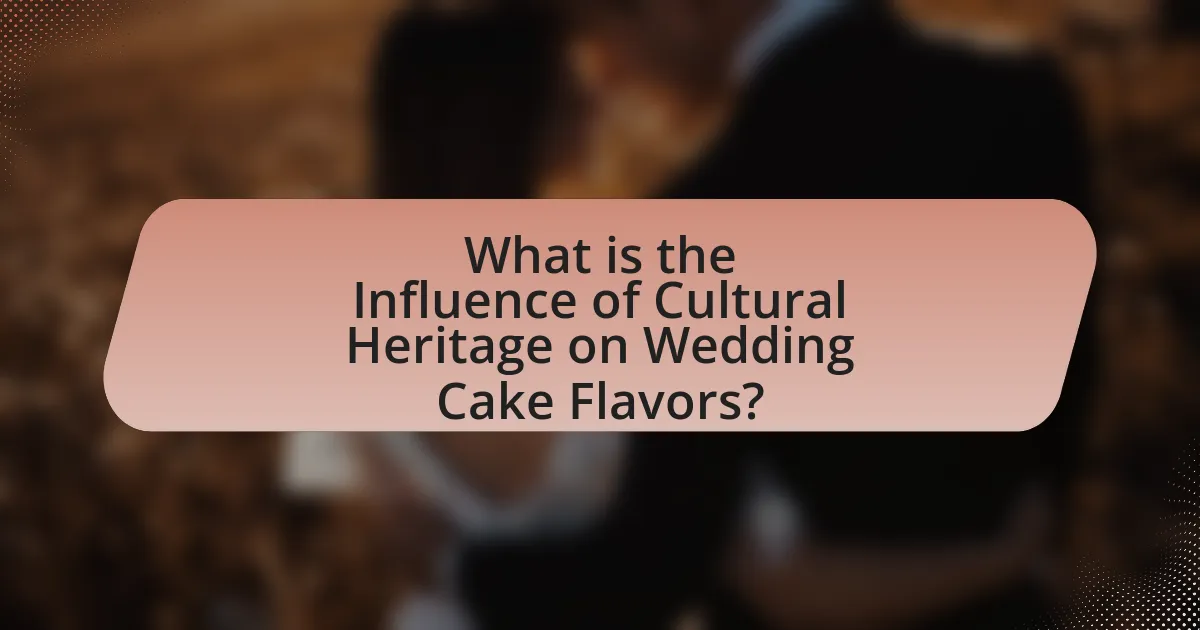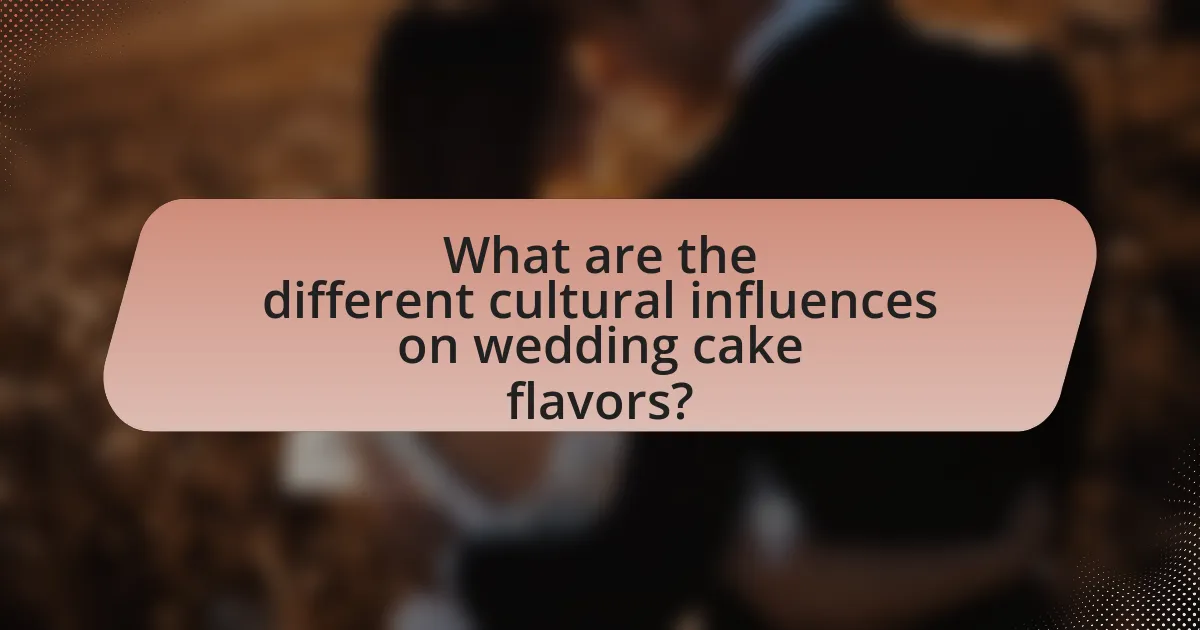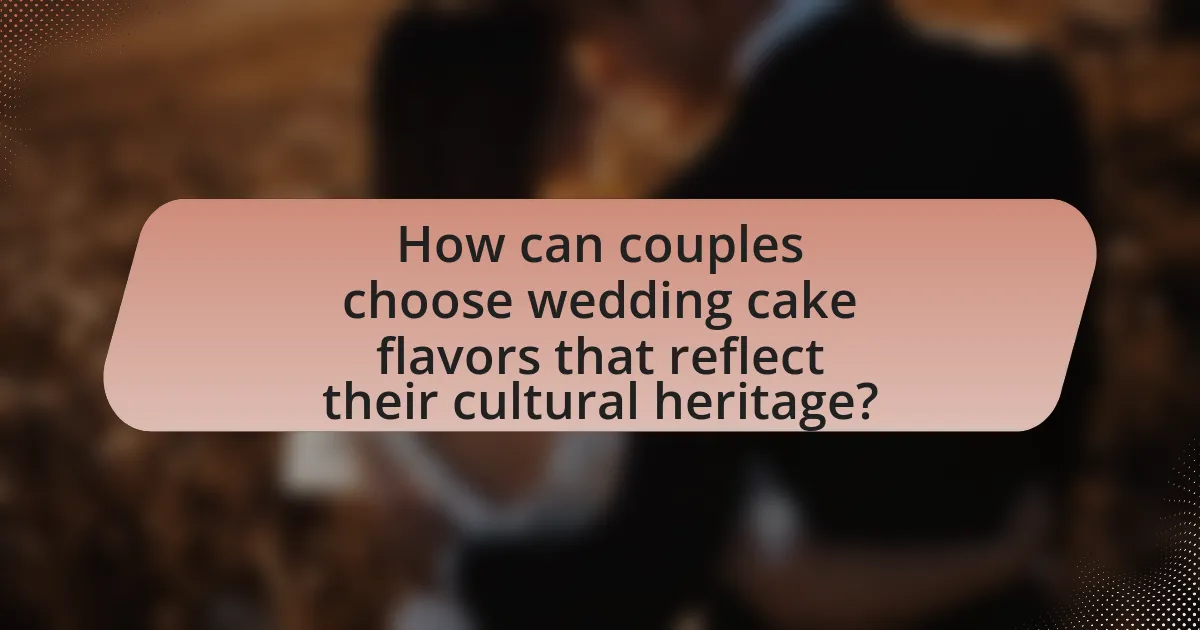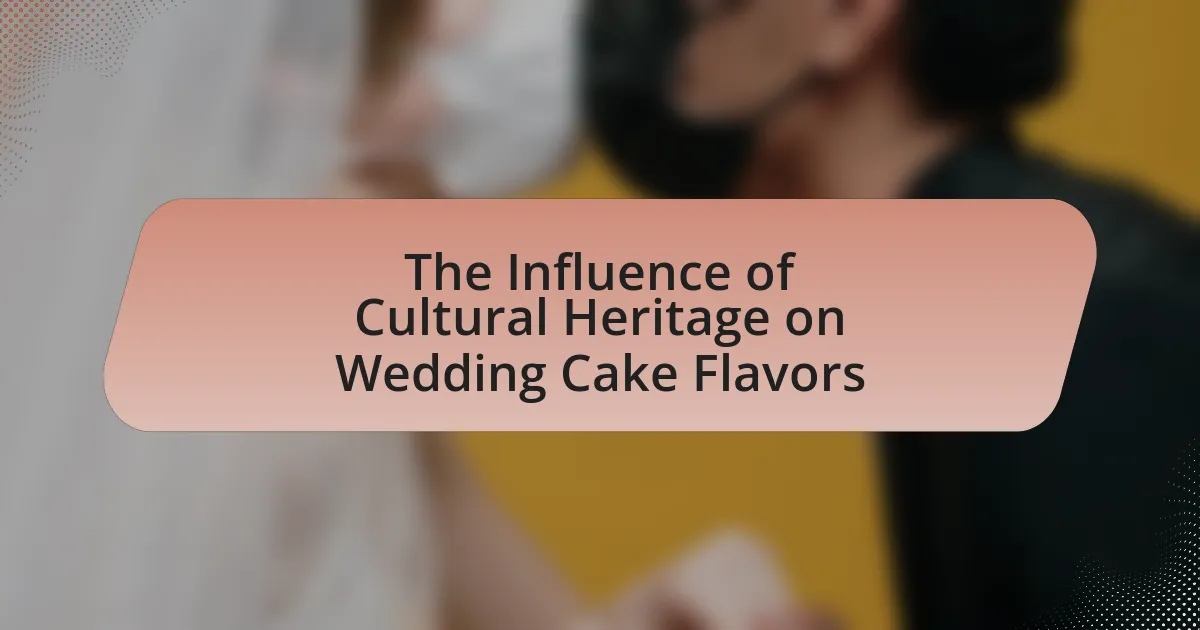The article examines the influence of cultural heritage on wedding cake flavors, highlighting how traditional ingredients and recipes reflect regional customs and historical practices. It discusses the impact of cultural factors such as regional traditions, religious practices, and family heritage on flavor selection, providing examples from various cultures, including Italian, Indian, and British weddings. The article also explores how modern couples blend cultural influences in their wedding cakes, the significance of personal stories and family traditions in flavor choices, and offers tips for incorporating cultural heritage into cake designs. Additionally, it addresses common pitfalls to avoid when selecting flavors based on cultural backgrounds.

What is the Influence of Cultural Heritage on Wedding Cake Flavors?
Cultural heritage significantly influences wedding cake flavors by incorporating traditional ingredients and recipes that reflect regional customs and historical practices. For example, in Italian weddings, the use of ricotta cheese and citrus flavors in cakes like Cassata is prevalent, showcasing the country’s culinary history. Similarly, in Indian weddings, flavors such as cardamom and saffron are common, reflecting the spices integral to Indian cuisine. These flavor choices not only honor cultural traditions but also enhance the celebratory nature of weddings, making the cake a symbol of cultural identity.
How does cultural heritage shape the flavors of wedding cakes?
Cultural heritage significantly shapes the flavors of wedding cakes by influencing ingredient choices, preparation methods, and flavor profiles that reflect regional traditions. For instance, in Italian weddings, cakes often feature ricotta and citrus flavors, while in Indian weddings, cakes may incorporate spices like cardamom and saffron, showcasing local culinary practices. Historical practices, such as the use of fruitcake in British weddings, further illustrate how cultural customs dictate flavor preferences. These variations highlight the importance of cultural identity in culinary expressions, making wedding cakes a reflection of the couple’s heritage and familial traditions.
What are the key cultural factors that influence wedding cake flavors?
Key cultural factors that influence wedding cake flavors include regional traditions, religious practices, and family heritage. Regional traditions dictate popular flavors based on local ingredients and culinary customs; for example, fruitcakes are common in British weddings, while sponge cakes are favored in Italian celebrations. Religious practices can also shape flavor choices, as certain cultures may prefer specific ingredients that align with dietary laws, such as avoiding alcohol in Jewish weddings. Additionally, family heritage plays a significant role, as couples often choose flavors that reflect their ancestry or family recipes, ensuring that the cake honors their cultural background. These factors collectively shape the flavor profiles of wedding cakes, making them a reflection of cultural identity and tradition.
How do regional ingredients reflect cultural heritage in wedding cakes?
Regional ingredients in wedding cakes reflect cultural heritage by showcasing local agricultural practices, traditional recipes, and historical influences. For instance, a wedding cake made in Italy often features ingredients like ricotta and citrus, which are staples in Italian cuisine and highlight the region’s agricultural bounty. Similarly, in the Southern United States, wedding cakes may incorporate pecans and peaches, reflecting the local farming culture and culinary traditions. These ingredients not only enhance the flavor profile of the cakes but also serve as a representation of the community’s identity and history, connecting couples to their roots and familial customs.
Why is understanding cultural heritage important for wedding cake flavors?
Understanding cultural heritage is important for wedding cake flavors because it informs the choice of ingredients, techniques, and traditions that reflect a couple’s background and values. Cultural heritage shapes flavor profiles, such as the use of spices in Indian weddings or fruit in Mediterranean celebrations, ensuring that the cake resonates with the couple’s identity and family customs. This connection to heritage enhances the significance of the wedding cake, making it a meaningful symbol of unity and cultural expression during the celebration.
How does cultural heritage enhance the significance of wedding cakes?
Cultural heritage enhances the significance of wedding cakes by embedding traditional flavors, designs, and rituals that reflect a community’s identity and values. For instance, in many cultures, specific ingredients or cake styles are associated with particular ceremonies, symbolizing prosperity, fertility, or unity. In Italy, the traditional wedding cake, known as “Torta Nuziale,” often features layers of fruit and nuts, representing abundance and good fortune. Similarly, in India, wedding cakes may incorporate spices and flavors that resonate with regional customs, reinforcing familial bonds and cultural . These elements not only elevate the cake’s importance as a culinary centerpiece but also serve as a tangible connection to cultural history and collective memory.
What role does tradition play in the selection of wedding cake flavors?
Tradition significantly influences the selection of wedding cake flavors by guiding couples toward flavors that reflect cultural heritage and familial customs. Many cultures have specific flavors associated with weddings, such as fruitcake in British traditions or almond cake in Italian weddings, which symbolize prosperity and fertility. These traditional flavors are often chosen to honor family history and cultural practices, ensuring that the wedding cake serves not only as a dessert but also as a representation of shared values and heritage.

What are the different cultural influences on wedding cake flavors?
Different cultural influences on wedding cake flavors include regional ingredients, traditional recipes, and symbolic meanings associated with specific flavors. For example, in Italy, wedding cakes often feature flavors like almond and citrus, reflecting the Mediterranean climate and local agricultural products. In contrast, British wedding cakes typically use rich fruitcake, symbolizing prosperity and good fortune, while in India, wedding cakes may incorporate spices like cardamom and saffron, representing cultural heritage and celebration. These variations illustrate how cultural backgrounds shape the choice of flavors, making wedding cakes a reflection of the couple’s heritage and traditions.
How do various cultures approach wedding cake flavors?
Various cultures approach wedding cake flavors by incorporating traditional ingredients and regional preferences that reflect their heritage. For instance, in Italy, wedding cakes often feature flavors like almond and citrus, with the traditional Millefoglie being a popular choice, while in the UK, fruitcake is favored, often soaked in alcohol and adorned with marzipan. In India, wedding cakes may include flavors such as cardamom and saffron, reflecting local spices, while in Japan, matcha and red bean flavors are common, showcasing the country’s unique ingredients. These flavor choices are influenced by historical practices, local agriculture, and cultural significance, demonstrating how wedding cakes serve as a culinary representation of cultural identity.
What are the traditional flavors associated with Western wedding cakes?
Traditional flavors associated with Western wedding cakes include vanilla, chocolate, and almond. These flavors have been popular due to their wide appeal and versatility in pairing with various fillings and frostings. Vanilla is often considered the classic choice, while chocolate adds richness, and almond provides a unique, nutty flavor. Historical preferences have shaped these choices, with vanilla being favored since the 19th century for its lightness and ability to complement other ingredients.
How do Eastern cultures incorporate unique flavors into wedding cakes?
Eastern cultures incorporate unique flavors into wedding cakes by utilizing traditional ingredients and regional spices that reflect their culinary heritage. For example, in Indian weddings, cakes often feature flavors like cardamom, saffron, and coconut, which are staples in Indian desserts. Similarly, in Chinese weddings, cakes may include red bean paste or matcha, symbolizing good fortune and prosperity. These flavors not only enhance the taste but also carry cultural significance, as they are often associated with celebrations and rituals. The use of these distinctive ingredients showcases the rich diversity of Eastern culinary traditions and their influence on wedding cake flavors.
What are some examples of fusion wedding cake flavors?
Some examples of fusion wedding cake flavors include matcha green tea and vanilla, chocolate and chai spice, and coconut and lime. These combinations reflect the blending of different cultural influences, such as Japanese matcha with Western vanilla, Indian chai spices with classic chocolate, and tropical coconut with zesty lime. The popularity of these flavors demonstrates how cultural heritage can inspire innovative culinary creations in wedding cakes.
How do modern couples blend cultural influences in their wedding cakes?
Modern couples blend cultural influences in their wedding cakes by incorporating traditional flavors, designs, and techniques from their diverse heritages. For instance, a couple may choose a cake that features layers of Italian tiramisu, Indian spices, or Japanese matcha, reflecting their respective backgrounds. This fusion not only honors their individual cultures but also creates a unique culinary experience for their guests. According to a survey by The Knot, 40% of couples reported incorporating cultural elements into their wedding cakes, showcasing the growing trend of personalization in wedding celebrations.
What are popular fusion flavor combinations in wedding cakes?
Popular fusion flavor combinations in wedding cakes include matcha and vanilla, chocolate and chili, and coconut and lime. These combinations reflect a blend of cultural influences, such as the incorporation of matcha from Japanese cuisine, which adds a unique earthy flavor to the sweetness of vanilla. Chocolate and chili combine traditional Western chocolate cake with a hint of spice, creating a complex flavor profile that appeals to diverse palates. Coconut and lime merge tropical flavors, often found in Caribbean desserts, with the richness of cake, offering a refreshing twist. These combinations are increasingly favored for their ability to celebrate cultural heritage while providing a modern twist on classic wedding cake flavors.

How can couples choose wedding cake flavors that reflect their cultural heritage?
Couples can choose wedding cake flavors that reflect their cultural heritage by researching traditional desserts and flavors from their backgrounds. For instance, if one partner has Italian heritage, they might consider flavors like tiramisu or cannoli, which are integral to Italian cuisine. Additionally, couples can incorporate spices, fruits, or ingredients that are significant in their cultures, such as cardamom in Indian desserts or coconut in Caribbean sweets. This approach not only honors their ancestry but also creates a personalized experience for their wedding celebration.
What factors should couples consider when selecting flavors?
Couples should consider personal preferences, cultural significance, and dietary restrictions when selecting flavors for their wedding cake. Personal preferences ensure that the chosen flavors resonate with the couple’s tastes, while cultural significance can enhance the wedding experience by incorporating traditional flavors that reflect their heritage. Dietary restrictions, such as allergies or vegan choices, are crucial to ensure all guests can enjoy the cake. For instance, a survey by The Knot found that 40% of couples choose flavors based on family traditions, highlighting the importance of cultural influence in flavor selection.
How can personal stories influence flavor choices?
Personal stories significantly influence flavor choices by creating emotional connections to specific tastes and ingredients. These narratives often stem from cultural heritage, family traditions, or memorable experiences associated with particular flavors, leading individuals to prefer those that evoke nostalgia or personal significance. For instance, a wedding cake flavor inspired by a grandmother’s recipe may resonate deeply with the couple, making them more likely to choose that flavor for their celebration. Research indicates that emotional memories tied to food can enhance flavor perception and preference, reinforcing the idea that personal stories shape culinary decisions.
What role do family traditions play in flavor selection?
Family traditions significantly influence flavor selection by shaping preferences based on cultural heritage and familial practices. These traditions often dictate specific flavors that are associated with celebrations, such as weddings, where certain tastes evoke nostalgia and familial bonds. For instance, a study published in the Journal of Culinary Science & Technology highlights that families often pass down recipes that reflect their cultural backgrounds, leading to a preference for flavors that resonate with their heritage. This connection to tradition not only enhances the emotional significance of the flavors chosen but also reinforces cultural identity during important life events like weddings.
What are some tips for incorporating cultural heritage into wedding cake flavors?
Incorporating cultural heritage into wedding cake flavors can be achieved by selecting traditional ingredients and recipes that reflect the couple’s backgrounds. For example, using spices like cardamom or saffron can evoke Middle Eastern heritage, while flavors like matcha or red bean can represent Japanese culture. Additionally, couples can consider regional specialties, such as incorporating fruit preserves or nuts that are significant in their family traditions. This approach not only personalizes the cake but also honors the couple’s ancestry, creating a meaningful connection to their heritage during the celebration.
How can couples work with bakers to create culturally inspired cakes?
Couples can collaborate with bakers to create culturally inspired cakes by sharing their cultural backgrounds and specific traditions that they wish to incorporate into the cake design and flavors. This collaboration can involve discussing traditional ingredients, flavors, and decorative elements that reflect their heritage, such as using spices or fruits native to their culture. For instance, a couple with Indian heritage might request a cake flavored with cardamom and saffron, while a couple with Italian roots might prefer a ricotta-based cake. By providing bakers with detailed information about their cultural preferences, couples ensure that the final cake not only tastes authentic but also visually represents their cultural identity.
What are common pitfalls to avoid when choosing flavors based on cultural heritage?
Common pitfalls to avoid when choosing flavors based on cultural heritage include oversimplification of cultural elements, misrepresentation of traditional flavors, and neglecting regional variations. Oversimplification occurs when one assumes that a single flavor represents an entire culture, which can lead to a lack of authenticity. Misrepresentation happens when flavors are altered or combined in ways that do not reflect their true cultural significance, potentially offending those who hold those traditions dear. Additionally, neglecting regional variations can result in a failure to honor the diversity within a culture, as different areas may have unique interpretations of traditional flavors. These pitfalls can undermine the integrity of the cultural heritage being represented in wedding cake flavors.
